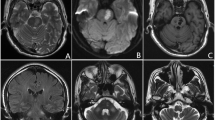Abstract
Magnetic resonance (MR) images of seven patients with olivary degeneration caused by cerebellar or brain stem haemorrhages were reviewed. In four patients with cerebellar haemorrhage, old haematomas were identified as being located in the dentate nucleus; the contralateral inferior olivary nuclei were hyperintense on proton-density- and T2-weighted images. In two patients with pontine haemorrhages, the old haematomas were in the tegmentum and the ipsilateral inferior olivary nuclei, which were hyperintense. In one case of midbrain haemorrhage, the inferior olivary nuclei were hyperintense bilaterally. The briefest interval from the ictus to MRI was 2 months. Hypertrophic olivary nuclei were observed only at least 4 months after the ictus. Olivary degeneration after cerebellar or brain stem haemorrhage should not be confused with ischaemic, neoplastic, or other primary pathological conditions of the medulla.
Similar content being viewed by others
References
Guillain G, Mollaret P (1931) Deux cas de myoclonies synchronés et rythmées vélo-pharyngo-laryngo-oculo-diaphragmatiques. Le probleme anatomique et physio-pathologique de ce syndrome. Rev Neurol 2: 545–566
Gautier JC, Blackwood W (1961) Enlargement of the inferior olivary nucleus in association with lesions of the central tegmental tract or dentate nucleus. Brain 84: 341–361
Jellinger K (1973) Hypertrophy of the inferior olives. Report on 29 cases. Z Neurol 205: 153–174
Sperling MR, Herrmann C, Jr (1985) Syndrome of palatal myoclonus and progressive ataxia: two cases with magnetic resonance imaging. Neurology 35: 1212–1214
Yokota T, Hirashima F, Furukawa T, Tsukagoshi H, Yoshikawa H (1989) MRI findings of inferior olives in palatal myoclonus. J Neurol 236: 115–116
Hirono N, Kameyama M, Kobayashi Y, Udaka F, Mezaki T, Abe K, Nishitani N (1990) MR demonstration of a unilateral olivary hypertrophy caused by pontine tegmental hematoma. Neuroradiology 32: 340–342
Zarranz JJ, Fontan A, Forcadas I (1990) MR imaging of presumed olivary hypertrophy in palatal myoclonus. AJNR 11: 1164
Dubinsky RM, Hallett M, Di Chiro G, Fullham M, Schwankhaus J (1991) Increased glucose metabolism in the medulla of patients with palatal myoclonus. Neurology 41: 557–562
Revel MP, Mann M, Brugières P, Poirier J, Gaston A (1991) MR appearance of hypertrophic olivary degeneration after contralateral cerebellar hemorrhage. AJNR 12: 71–72
Bontozoglou NP, Chakeres DW, Martin GF, Brogan MA, McGhee RB (1991) Cerebellorubral degeneration after resection of cerebellar dentate nucleus neoplasms: evaluation with MR imaging. Radiology 180: 223–228
Pierot L, Cervera-Pierot P, Delattre J-Y, Duyckaerts C, Chiras J, Brunet P (1992) Case report. Palatal myoclonus and inferior olivary lesions. MRI-pathologic correlation. J Comput Assist Tomogr 16: 160–163
Goto N, Kaneko M (1981) Olivary enlargement: chronological and morphometric analyses. Acta Neuropathol (Berl) 54: 275–282
Author information
Authors and Affiliations
Rights and permissions
About this article
Cite this article
Uchino, A., Hasuo, K., Uchida, K. et al. Olivary degeneration after cerebellar or brain stem haemorrhage: MRI. Neuroradiology 35, 335–338 (1993). https://doi.org/10.1007/BF00588362
Issue Date:
DOI: https://doi.org/10.1007/BF00588362




